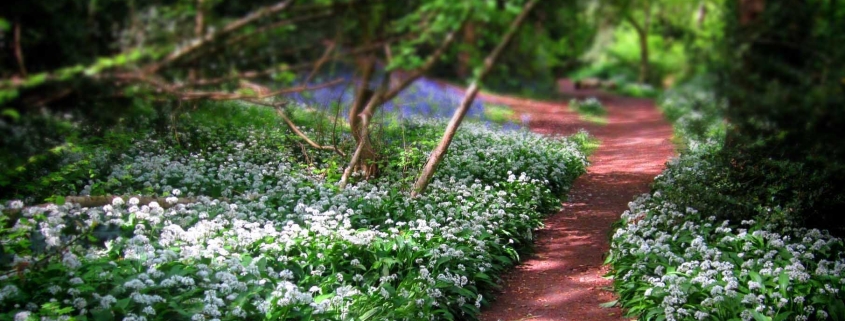
Batts Copse
Batts Copse is part of Sibden Hill and Batts Copse Local Nature Reserve. It lies right in the heart of Shanklin, surrounded by housing on all sides. It provides an oasis in the middle of town for wildlife and people alike. The two parts of the Nature Reserve are linked by a public footpath.
Batts Copse nestles in the relatively steep-sided valley of a small brook, part of which has been modified to accommodate a pipe. The woodland through the gorge is heavily shaded and the ground flora consists of hart’s tongue and maidenhair fern, nettle, bramble and cleavers. The wood south of the gorge, however has a longer history and the ground flora includes wood anemone, bluebell, ramsons and pendulous sedge. The three cornered leek is a distinctive plant in late spring and early summer. The canopy on this side of the stream is largely old, with wide spreading hazel and some oak standards. The northern part of the woodland is dominated by sycamore and wild cherry. The woodland is home to a variety of mammals including fox, bats, and hedgehog. Badger and red squirrel are known to visit the site. Scrub areas in Batts Copse have been cleared and planted with hazel and silver birch. The scrub attracts redwing, greenfinch, bullfinch and song thrush. There are also grass snakes, slow worms, common frog and common toad.
What to look and listen for …
In spring Batts Copse has a lovely display of bluebells and wood anemones, also look out for Maidenhair Fern and Harts Tongue Ferns – both like the shady environment. In winter look up, there are many nests in the branches, if you see of flash or pinky-red in the branches it could be a male bullfinch. We have alien invaders – the Laurel and Rhododendron shouldn’t really be here,
In early morning the song thrush serenades you with a loud and clear song, at other times you may hear it bashing snails on stones to crack their shells. Listen to the babbling brook – imaginatively called ‘The Brook’ as it passes through the site and if you hear long flatulent sounds and cough calls its probably common toads.
… and smell and touch
The classic fragrance of the bay bushes – what does it remind you of? Can you smell the bluebells? If so, they will be English ones. Stinking iris loves the wet environment alongside the brook and three cornered leek gives Batts Copse a distinct whiff in Spring.
There are a variety of tree species, hug them or feel the difference in bark, some are very rough, others incredibly smooth and feel the soft moss on the stone wall. In summer you will probably find that the cleavers are sticking to you!
Nature at home and activities on site
We have produced a super Colouring Sheet for you to download and complete at home. We have also produced an I Spy Sheet and Map for you to print at home, or download to your phone and take to the site. And become a Bug Bunch Ranger. All these activities and resources can be found here.
Managing the site
The steep woodland means that the trees are stressed and sometimes need to be cut down or coppiced. We leave the wood on site to create brilliant habitat.
How to get there
On foot – Footpaths SS15 and SS90 lead to Batts Copse. SS99 links Batts Copse to Sibden Hill. The Red Squirrel Trail (NCN 23) passes near the site and has an access track onto carter Avenue. Batts Copse can also be accessed from Batts Road and Copse Road.
By bus or train – Shanklin bus station (Routes 2/3/22/24). Walk north 90 metres and turn left into Collingwood Road. Walk approximately 430 metres and enter via Footpath SS14 on the south (left) side of the road. Carter Avenue (Route 22). Walk easterly for approximately 60 metres and enter via Footpath SS14 on the south (right) side of the road . (Bus Timetables)
By car and bike – There are several entrances to Batts Copse. In all instances off-road parking can be found but not immediately adjacent to the site. Entrances are from Batts Road, Garfield Road, Copse Road and Collingwood Road – see our Access Statement for fuller directions. Suggested code for SATNAV is PO37 7NU.
what3words for Batts Copse Batts Road entrance ///grounding.toasted.swim
Access
Most of this site is steeply sloping and all paths are unsurfaced. There are steps on both sites.
There is an Information Pillar at the entrance from Batts Copse Road. The site Information Pillar has a QR code that links to an audible description creating a mind’s eye view of the area to allow a visually impaired person to enter with confidence. The information pillar also has a QR code that links to a map and activities. There is also a site map on the Information Pillar.
There are no toilets on site. The nearest public toilets are in Shanklin where you can find many refreshment opportunities.
We have written an Access Statement for this site. This includes mobility and sensory issues and opportunities. We welcome feedback from users.

We have produced an audible description creating a mind’s eye view of the area to allow a visually impaired person to enter with confidence. It will describe the entrance, the size of the area, where to find further information or help and any major obstacles or features. Information has been produced by visually impaired people ensuring it is useful and accurate. Access the description by scanning the QR code to the left of this text on your phone or tablet, or by clicking here.
Get Involved
There are various ways you can help improve and maintain our sites. We rely on volunteers to help with many tasks on our sites and also need people who are happy to regular visit the site be our “eyes and ears”, this means we can respond much quicker to issues. Our shop raises money to support our work and needs a team of volunteers. Or maybe you would like to help us with events. Find out more here.
You can also help by becoming one of our regular supporters. Even giving a few pounds each month can make a real difference, with your donation being invested into site management and improvement work to benefit site visitors and look after our precious wildlife. Sign up here
